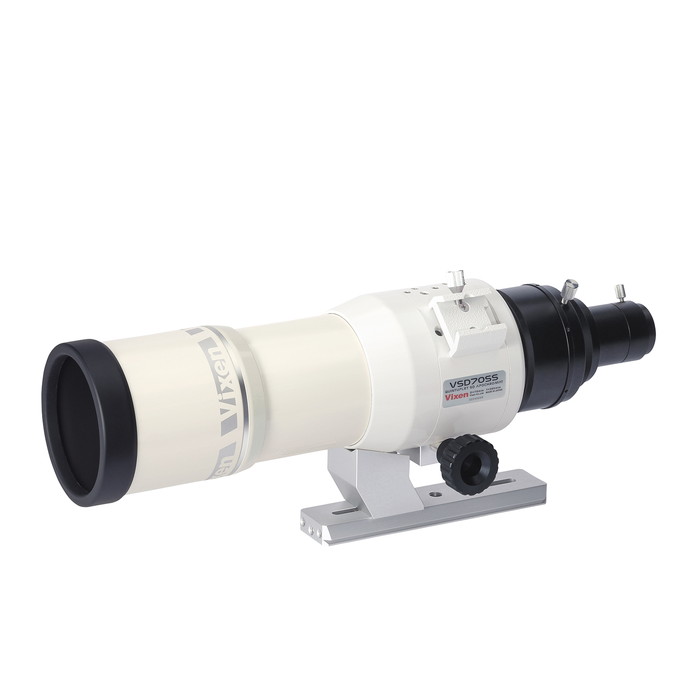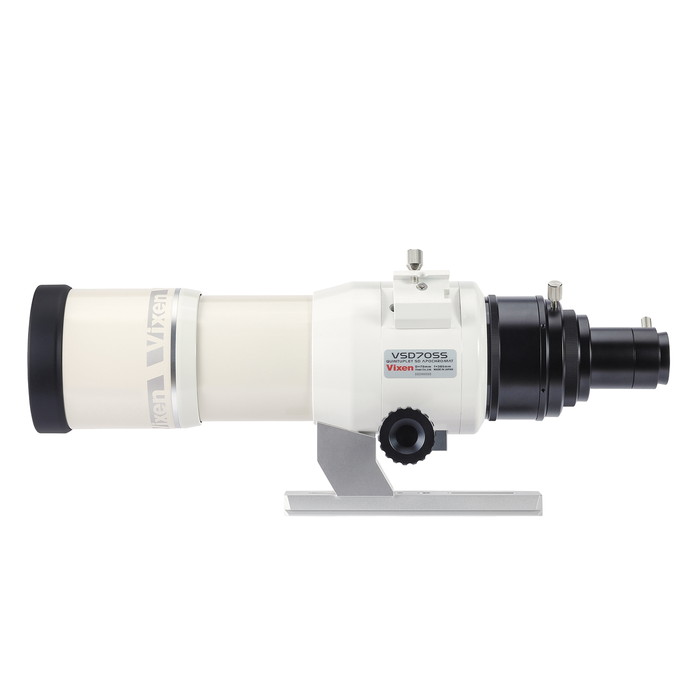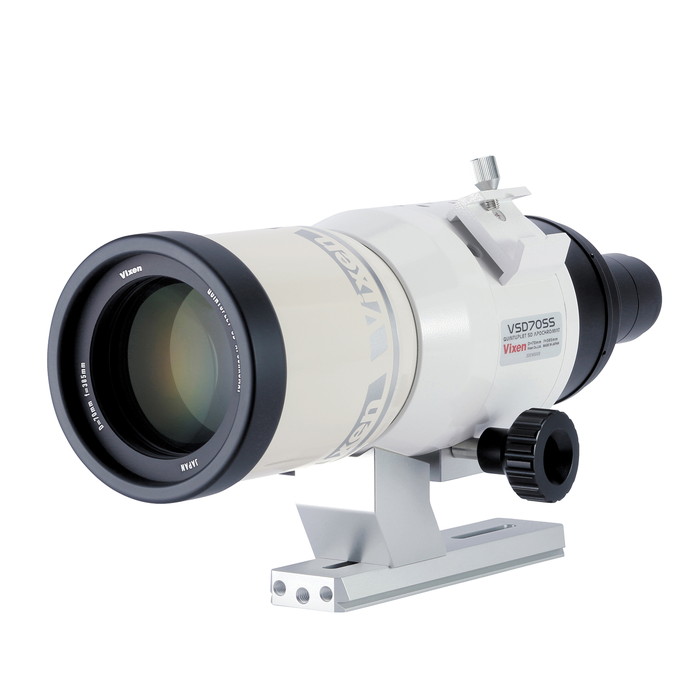Vixen | Producer of optics from astronomical telescopes and binoculars
Vixen Telescope VSD70SS Optical Tube Assembly








loading
Suggested retail price: Contact local dealer
Very compact model inheriting the ease of use and excellent performance of the flagship model VSD90SS
The luxurious optical design of 5 elements in 5 groups including 2 SD lenses and 1 ED lens realizes an optical system that is nearly aberration-free. You can obtain sharp, beautiful and uniform star images from the center of the field of view to the very periphery of the 35mm full-frame as well as the 44x33mm large format. This photovisual telescope also demonstrates high performance in visual observation from stargazing with a wide field of view to planetary observation at high magnification.
Vixen Telescope VSD70SS Optical Tube Assembly Description
-
Sharp, beautiful and uniform star images across the entire large format surface
VSD70SS 385mm F5.5
PENTAX 645Z large format image field, total exposure time 60 minutes

The convex lens uses two SD lenses and one high-refractive index ED lens (5 groups, 5 elements), and the front concave lens uses newly developed high-performance lanthanum glass. This successfully minimizes axial chromatic aberration and astigmatism providing extremely sharp, beautiful and uniform star images from the center to the very periphery of the 35mm full-frame image as well as the 44x33mm large format image. *The full-frame image is reduced to 36x24mm if the reducer is used.
-
Designed to stably produce beautiful and star images


Regardless of the user's skill, the VSD70SS focuses on the "gentleness of the peak" in the setting accuracy so that satisfactory shooting results can be obtained stably. Since it is designed with a wide focus range that fits within the airy disc, color changes and collapse of star images at the periphery of the field are unlikely to occur even if there is some deviation in the focus accuracy or squaring. This ensures that sharp, beautiful and uniform star images are always obtained over the entire imaging field and stable shooting results can be expected, including image processing after shooting. You can be sure to make the most of your precious shooting opportunities.
-
Abundant light without vignetting

Generally astrographs have peripheral light falloff caused by vignetting, so it is not uncommon for image processing such as peripheral light falloff correction to be required after shooting. Therefore, the VSD70SS uses a large-diameter lens in the rear optical system to ensure more than 90% of the light at the very edge of the image circle dia. 55mm. Since the amount of light is uniform over the entire field of view, it is expected that peripheral light falloff correction through image processing will not be necessary or will be easier to process.
-
Rich tones and beautiful star images over the entire field of view

The low vignetting not only maintains an abundance of peripheral light, but also eliminates non-axisymmetric flare of bright stars caused by light diffraction, preventing star image distortion at the periphery of the field of view. In addition, you can expect beautiful photographic results, along with the rich gradation obtained by the abundant peripheral light.*Depending on the shooting system, vignetting may occur due to the camera body, camera mount, etc.
-
The MTF characteristics showing high resolution and high contrast


The MTF stands for "Modulation Transfer Function" and is an evaluation index of lens performance expressed as spatial frequency characteristics. It indicates how well the lens's resolving power and the contrast of the subject can be reproduced on the image plane. The graph has the distance from the center of the image on the horizontal axis and the contrast value (maximum 1) on the vertical axis. The closer the 10 lines/mm curve (red) is to 1, the higher the contrast, and the closer the 30 lines/mm curve (blue) is to 1, the higher the resolution. With the VSD70SS, all contrast values ??are close to 1, indicating that it is an extremely excellent optical system.
-
Flat image surface, Strehl strength 96.7% and perfect for visual observation
The VSD70SS has an extremely flat image plane, so when combined with a high-quality eyepiece, a sharp image spreads over the entire field of view when observing with the naked eye at low magnification and a wide field of view. Furthermore, the center of the field of view boasts a multi-wavelength Strehl intensity of 96.7%. With imaging performance that exceeds the 95.7% of the SD81S II which is well-known as a high-performance apochromat, the VSD70SS is also suitable for high-magnification observation of planets and other objects.
-
Versatile large eyepiece section

To make the most of the wide 55mm dia image circle and abundant peripheral light, the VSD70SS uses a large 87.5mm dia eyepiece. It is compatible with a wide range of accessories and can be used for a variety of observation scenes, including large-format and full-frame format photography and visual observation.



-
High precision drawtube clamp

It is equipped with a clamp that securely fixes the drawtube when heavy equipment such as a large format camera or a large cooled CCD camera is attached. The rack gear is fixed by clamping it from the side, so that the angle of view does not move even when the clamp is tightened after adjusting the composition and focus.
-
Focuser support


You can attach a dual-speed focuser (optional) or a ZWO EAF (electric focuser) for more precise focusing.
-
Compact short optical tube for easy storage

The overall length is about 444mm when using the VSD70SS. If the retractable objective dewshield is stored, overall length will be reduced to 368mm (min. 299mm by removing parts such as the eyepiece adapter). It is stored very compactly making it easy to transport.
-
A variety of optional accessories to support observation
1. VSD70SS Case
2. Reducer V0.71X
3. Wide Photo Adapter 60DX
4. Camera Mount 645D
5. Dual speed focuser"

Specifications
VSD70SS Optical Tube Assembly
-
Objective Design / Effective ApertureFive-group five-element SD Apochromat, AS coatings / 70mm
-
Focal Length (Focal Ratio)385mm (F5.5)
-
Resolving Power・Limiting Magnitude1.66 arc seconds・11.0
-
Light Gathering Power100X unaided eye
-
Image Circle55mmφ(Over 90% illumination at the round edge)
-
Optical Tube Size・Weight90mm dia. X 368-444mm long (shortened at 299mm long), 3.5kg
-
Finder ScopeNot included, optional 7X50mm Finder scope II, 50mm XY Finder bracket II
-
Focusing SystemRack-and-pinion
-
Accssory Threads / SizeThreads/ 84mm (pitch 1mm), 60mm (pitch 0.75mm), 42mm for T-ringPush-fit / 60.2mm, 50.8mm, and 31.7mm
-
Eyepiece (31.7mm)Not included.
-
Plates and/or Tube RingsDual slide bar
-
Provided AccessoriesVSD60.2 to 50.8 Adapter, 1/4inch screw (L:9mm) x 2 pcs., Allen wrenches (3mm,2mm, 1.5mm and 3/16inch)
-
PhotographyEyepiece Projection, Prime Focus, and Aforcal Imaging with smartphone are possible
-
Solar ObservationUsing optional Sun projection screen Set B (Short-time observing is recommended)
-
Dimensions WxDxH444×144×174mm
-
Weight3.5kg
the set
- VSD70SS Optical Tube Unit
accesssory
- VSD60.2 to 50.8 Adapter
- 1/4inch screw (L:9mm) x 2 pcs.
- Allen wrenches (3mm, 2mm, 1.5mm, 3/16inch)
Share this page
